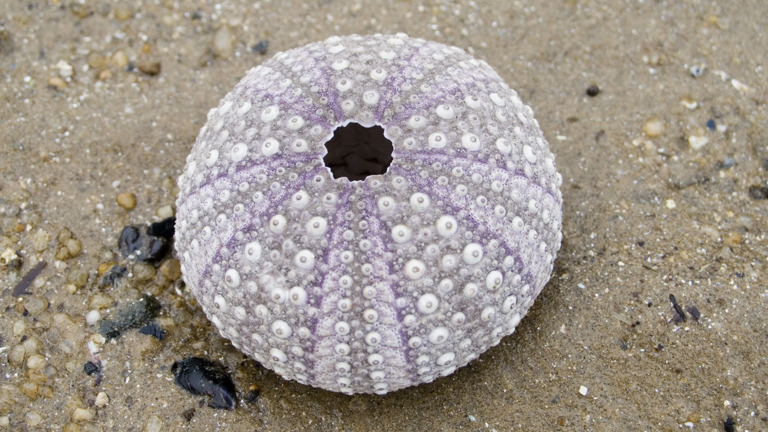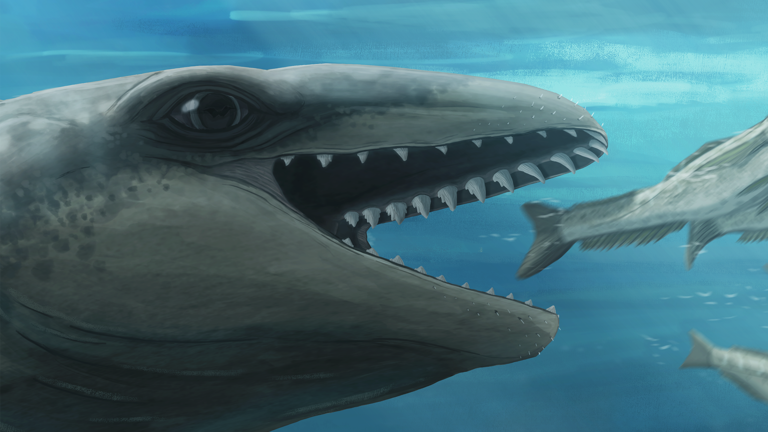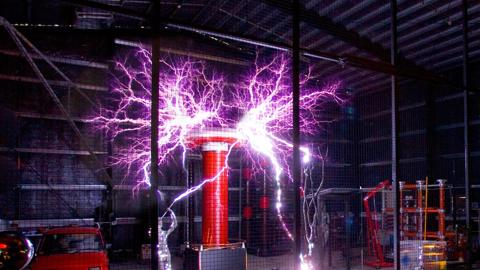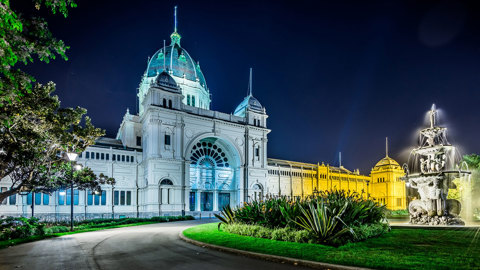
How sea ice helps us keep our cool
It may seem like a distant frozen corner of our globe, but the sea ice is important not just for the organisms and peoples that live amongst it, but for the entire planet.
As key Earth systems, environments like sea ice are an important area of research for Museums Victoria Research Institute and other organisations.
‘It never ceases to amaze me how the ocean can freeze, how it can be solid enough to walk on,’ says Dr Rob Massom, a sea ice scientist with the Australian Antarctic Division.
‘Sea ice is extraordinarily beautiful and endlessly fascinating. And it really matters.’
Sea ice forms each autumn through winter, when ocean surface temperatures plummet to about -1.8°C, sparking the formation of ice crystals. These crystals congregate on the surface into a frozen mass that can be anything from a few centimetres to a few metres thick.
In summer the warming weather melts some of the ice, while other areas remain ice-covered for multiple years. The vast seasonal advance and retreat of sea ice represents one of the greatest seasonal changes on Earth.
The seasonal sea ice formation and melt back in the Arctic (left) and Antarctic (right) oceans. Credit: NASA’s Scientific Visualization Studio
‘Seen from space with satellites, the annual cycles of sea ice formation and melt-back that transform the Arctic and Antarctic oceans look just like enormous beating hearts,’ says Dr Massom.
‘And the health of these icy beating hearts is crucial to the health of rich ecosystems that depend on them, the polar environments, and our planet’s weather patterns and climate system.’
How sea ice helps the climate
Sunlight warms the oceans.
Dark and vast, the seas soak up tremendous amounts of heat from the sun. But at the poles, things behave a little differently.
Sea ice and the snow that accumulates on top of it are highly reflective.
‘Sea ice forms a bright mass on the surface of the ocean that strongly reflects incoming sunlight in spring and summer,’ explains Dr Massom.
‘80-90% of incoming sunlight or solar radiation which would otherwise hit the ocean is reflected back into space.’
If not reflected, this heat would be absorbed into the ocean, warming the water and the surrounding atmosphere. A warmer ocean and atmosphere mean a warmer planet.
‘It really means that what [sea ice] is doing is keeping the polar regions cold and the Earth cool. Just from being there,’ says Dr Amelie Meyer, senior climate scientist and oceanographer.
'Every day, the ice is like a shield.'
‘It’s insulating the planet from the sun and it's instantaneous, and if you take away the ice instantaneously the planet heats up fast.’
Like a lid atop the water, the ice shields the ocean beneath from the warm heat of the sun. Beneath this frozen ‘lid,’ the sea is also protected from wind and waves. The water is relatively still.
While this water is cold by human standards (near freezing), it’s still warmer than the atmosphere (as low –40°C). In some cases, it’s warm enough to melt the underside of the ice into a layer of cold water, floating just beneath the ice.
This cold water is uninterrupted by wind or waves and doesn’t mix with the ocean below. Instead, it remains suspended just beneath the ice.
This cold, still layer of water becomes a physical barrier that insulates the ice from the warmer, deeper ocean beneath.
With its insulating layer of cold water underneath, the ice can survive for longer.
The melting of the ice is also affected by the snow sitting on its surface. The snow is a blanket. In winter, it insulates the sea ice from the cold air above, slowing down the freezing.
In the warmer months, the bright snow instead shields the ice from the sun’s warmth, slowing its melt.
‘Sitting on top of the sea ice, this blanket of snow substantially modifies the properties of the ice and its interplay with the polar ocean and atmosphere and ecosystems’, says Dr Massom.
‘It’s a wonderful marriage.’
Between the ice, the atmosphere and the ocean, this beautiful network of interactions keeps the ice cold and the climate cool.
How sea ice helps the oceans
Although sea ice is frozen seawater, the ice itself is much fresher than seawater.
As the water freezes it forces out salt, forming a salt-rich liquid called brine.
‘So as sea ice forms, you’ve got this brine rejection, salt rejection just underneath the ice, and that makes the water under the ice that’s forming super dense,’ explains Dr Meyer.
‘And when something is denser, which is heavier that what is around it, it sinks.’
Sea ice formation drives a current of water down and into the deep. Beneath the ice, the cold, salty water meanders to the abyssal ocean in a sluggish waterfall of brine, spreading along the sea floor.
If the water goes down, somewhere else on the planet water must come back up. As a result, water circulates through the ocean in a global conveyor belt of currents, transporting heat and moderating our climate.
This vital movement of water across the planet also transports oxygen, carbon and even living things, connecting the Antarctic to the Arctic. And it’s driven by sea ice.
As it forms, reshapes and melts under the influence of wind and currents, sea ice is a dynamic, ever-changing environment. It’s also teeming with life.
How sea ice helps the food web
Imagine that you could sink down below the ice.
In the calm, cold quiet of the sea ice and underlying upper ocean, you may expect to encounter a barren, frigid wasteland. But the underside of the sea ice is mottled with a filmy layer of green and brown, and its interior is alive with a plethora of micro-organisms highly adapted to this icy world.
‘Sea ice provides a wonderful, protected habitat for tiny plants—low-light adapted algae—to grow and proliferate,’ says Dr Massom.
‘This is in large part due to the microstructure of the ice itself—a beautiful lattice of ice crystals separated by miniscule pockets of brine, which provide mini apartments and key nutrients for algae.’
‘It's an optimal environment for them to float around and thrive in great numbers.’
But these floating icy meadows of algae aren’t isolated from the polar oceans and cut off from the rest of the world. At the bottom of the polar marine food chain, sea ice algae take up sunlight and carbon, just like any plant. And like any plant, they’re a vital food source.
‘The sea ice provides a well-stocked floating larder of algal culinary delights for tiny marine grazers such as copepods and krill, which then feed predators such as fish, penguins and whales,’ says Dr Massom.
When the ice starts to melt in the warmer months, the algae are bathed in sunlight and freshwater rich in nutrients previously trapped in the brine pockets, especially iron. This change triggers blooms of algae—also known as phytoplankton—at the receding sea-ice edge so large they can be seen from space.
A veritable feast.
‘A lot of creatures which are all interrelated within the polar food webs and ecosystems, are finely tuned to the rhythms of sea ice throughout the year,’ says Dr Massom.
‘If you disrupt the sea ice—such as its coverage and the annual timings of freezing and melting, then it disrupts the organisms that are dependent on the ice, and their complex interrelationships.'
‘It can have cascading effects through the ecosystem.’
With no ice algae and phytoplankton bloom, there’s less food for krill. Without krill, all sorts of polar animals such as fish, squids, seabirds, seals and whales are without a major source of food.
Through photosynthesis, these meadows and clouds of algae also remove carbon dioxide from the atmosphere and take it into the ocean.
Carbon dioxide that traps the Earth’s heat if it remains in the air, so reducing carbon dioxide in the atmosphere helps buffer against climate change.
While diverse communities of tiny organisms make their home in the lattice of ice crystals, the sea ice is also important breeding and feeding ground for animals including penguins, seals, and polar bears.
The dynamic and beautiful sea-ice environments are crucial for life on every scale, from tiny communities of microbial organisms living in miniscule within the ice, to the interconnected health of the entire ocean and its ecosystems.
‘A lot of the health of our planet depends on the health of these icy beating hearts, the seasonal comings and goings of the sea ice in both hemispheres,’ says Dr Massom.
Without sea ice, our whole world would be a fundamentally different place. From the microalgae that support the polar food webs to the movement of ocean currents, sea ice is a vital environment on—and critically important part of—the planet we call home.
Dr Rob Massom is a sea ice scientist. He currently leads the Australian Antarctic Division Sea Ice Group within the Antarctic Climate Program, and is a member of the Australian Antarctic Program Partnership and the Australian Centre for Excellence in Antarctic Science.
Dr Amelie Meyer is a physical oceanographer, and a Senior Fellow in Physical Oceanography at the Institute for Marine and Antarctic Studies, at the University of Tasmania. She is a Discovery Early Career Researcher Award holder through the Australian Research Council working on ocean mixing under sea ice.
By taking action on climate change we can reduce the harms of ocean heating, acidification and sea-level rise. Discover how you can play your part in helping to shape a thriving future for our oceans.
FAQ: Sea ice or land ice?
Ice sheets, glaciers, ice shelves and icebergs are not sea ice.
Glaciers form when snow falls on a landmass and accumulates for thousands of years. It becomes compacted under its own weight, forming thick ice.
Ice sheets are extremely large glaciers—over 50,000 square kilometres in area.
Ice shelves are connected to glaciers. Like liquid, glaciers gradually move, flowing like rivers towards the ocean. When the glaciers reach the ocean, they start to float in certain places. These floating sections of glacier are ice shelves.
Icebergs form when a section of ice shelf fractures, carves and drifts into the ocean, isolated from its original glacier.
None of these polar formations are formed by freezing seawater. They are types of glacial ice.
However, the fate of glaciers can still depend on sea ice. Pressed up against the land ice, sea ice helps to physically hold the ice sheet in place like a dam holding back a river.
While it’s not the melt of sea ice itself that contributes to rising sea levels, its loss directly impacts the melt of the ice sheet. Without the sea ice, land ice can run more rapidly into the ocean, where it can be melted by warm water and broken by waves. It is this melting of the land ice contained in the ice sheet that contributes to sea level rise.














